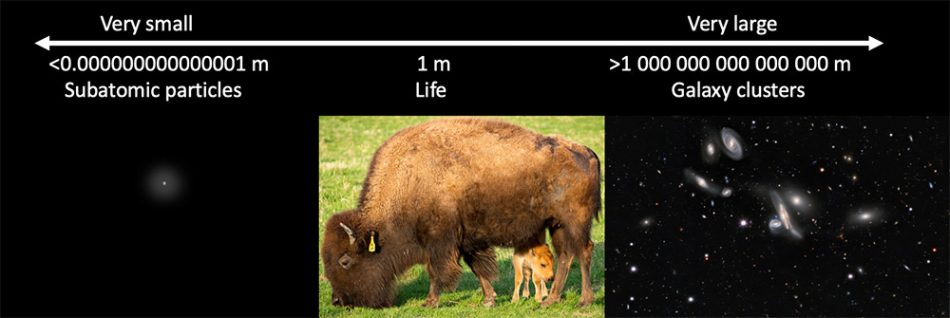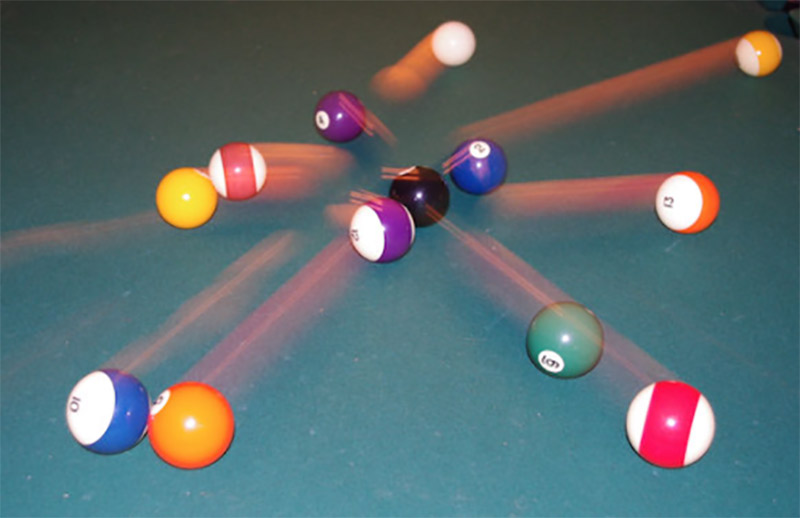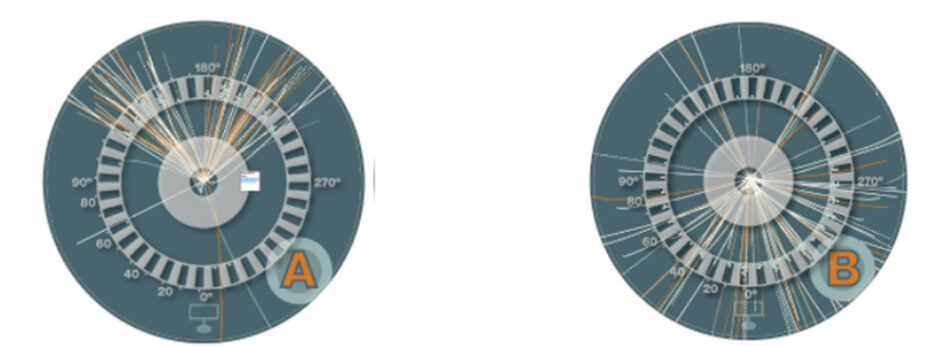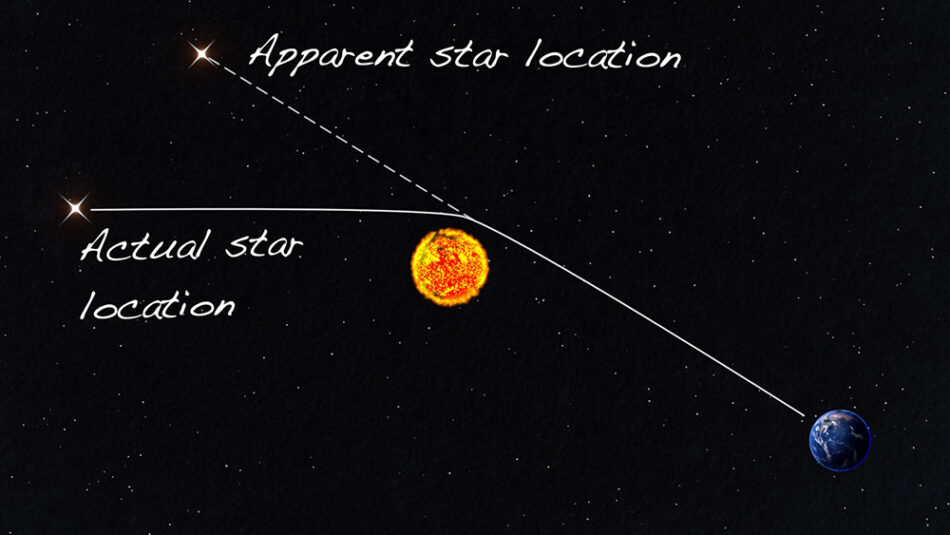Supporting materials
Download
Download this article as a PDF

How do physicists study very small objects (like molecules, atoms, and subatomic particles) and very large objects (such as galaxies) that cannot be directly observed or measured?
Imagine a single grain of sand. Subatomic particles, such as protons or neutrons, are a trillion times smaller than this grain of sand. Particle physicists study these tiniest building blocks of matter. To explore the invisible subatomic world, scientists build particle accelerators, create particle collisions, and try to observe patterns. Scientists analyse millions of different particle interactions and gather information about the properties of particles.
Now imagine a bison. Our galaxy, the Milky Way, is 1 000 000 000 000 000 000 000 times larger than a bison. Astrophysicists study very large objects, such as galaxies and galaxy clusters. They use the profound result of Einstein’s theory of general relativity – gravity bends the path of light – to explore and study astronomical bodies that are too far away to see, even with the most powerful telescopes.

Suggested age: 10 years and up (the activity should be done with adult supervision)
Estimated time for the activity: 20–30 minutes
Pre-lesson preparation time: 10–15 minutes
Most collisions in our world, from billiard balls to particles, can be described by one word: scattering. Physicists build particle accelerators to study particle collisions and their scattering patterns. They collect data, analyse particle interactions, find patterns, and learn about the basic building blocks of matter.

This activity demonstrates how scattering works. It introduces students to a method of identifying target shapes from characteristic scattering patterns.

Map how the ball bearings are scattered by different known surface types (curved, straight, slanted, etc.). Then ask your lab assistant to find a new object to hide under the cover. Roll the ball bearings at the new hidden object from multiple angles. Can you guess the shape and size of the new object based on the scattering patterns?
In the early 1900s, a team of physicists led by Ernest Rutherford fired positively charged alpha particles at a thin leaf of gold foil. Most of the particles passed straight through, but a few rebounded in odd directions. This experiment led to the discovery of the atomic nucleus, the positively charged part of the gold atoms that sent the alpha particles ricocheting away. Since then, scientists and engineers have used particle scattering to determine the microscopic structures of everything, from subatomic particles to proteins. Multiangle laser-light scattering is also used to determine the molecular weights of proteins and protein complexes.[1]
When ball bearings hit the target, they scatter in different directions. Different shapes produce different scattering patterns. Here are two examples: (A) is produced by an equilateral triangle, and (B) is produced by a disc. You will need to repeat your experiment for each shape several times before you see the scattering pattern. Then, based on the pattern, you can tell the shape of the hidden object.

Suggested age: 10 years and up (the activity should be done with adult supervision)
Estimated time for the activity: 20–30 minutes
Pre-lesson preparation time: 10–15 minutes
In space, light rays bend when passing near very massive objects, such as stars and galaxies. The presence of matter curves space, and the path of a light ray will be deflected as a result. Just like lenses bend light, supermassive objects (such as galaxies) bend light due to their powerful gravitational pull; therefore, this effect is called ‘gravitational lensing’.

Imagine a bowling ball sitting at the centre of a trampoline. The bowling ball acts as a massive object (like the sun or a galaxy) and the trampoline fabric acts as space-time. If you roll a small ball toward the bowling ball, it won’t follow a straight path. Instead, it will follow the curve in the trampoline and its trajectory will become ‘bent’ by the presence of the bowling ball. That’s what light does around very massive objects: the more massive the object, the more light will bend around it.

Use safety pins and a net to hang a massive object underneath the space-time fabric. Can you guess the mass of the object based on the trajectory of the ball bearings?
Physicists use gravitational lensing to determine the mass of galaxies and measure the amount of dark matter in the universe. Scientists think dark matter is plentiful and warps space-time, but it has so far evaded other forms of detection.[2–4]
The path of photons is distorted when they pass near a galaxy due to gravitational lensing. As space is warped by massive objects, light from a distant object bends as it travels to us, and we see a distorted image of it. The heavier the massive object, the more it distorts the path of light, so the distortion of light gives us information on the object’s mass.
Gravitational lenses provide an opportunity to study the properties of distant galaxies. An important consequence of lensing distortion is magnification, which allows us to observe objects that would otherwise be too far away and too faint to be seen. However, light can’t always escape the gravitational pull of supermassive objects: black holes are regions in space-time where gravity’s pull is so powerful that not even light can escape.
Suggested age: 10 years and up (the activity should be done with adult supervision)
Estimated time for the activity: 20–30 minutes
Pre-lesson preparation time: 10–15 minutes
Particle physicists study nature by using particle collisions. A particle’s energy is inversely proportional to its wavelength. High-energy particles have extremely small wavelengths and can probe nature at the subatomic level.[5] The higher the energy, the closer particles come to each other, revealing smaller details of their structure. Particle detectors are used to record the results of these high-energy collisions. Detectors can be thought of as giant digital cameras that are used to ‘photograph’ extremely small particles. This activity explains how one can probe shapes with different-sized pinheads and draws an analogy between particle energy/wavelength, resolution, and pinhead size.


Electron microscopes use a beam of electrons to examine objects on a very fine scale. In an optical microscope, the wavelength of light limits the maximum magnification that is possible. As electrons have a smaller wavelength, they can achieve a higher magnification, and can be used to see very small objects – typically around 1000 times smaller than those observed with an optical microscope. Scanning electron microscopes (SEMs) use an electron beam to image samples with a resolution down to the nanometre scale.

This experiment shows that higher resolution can be achieved with smaller pins: the smaller the pin size, the higher the resolution. Similarly, in particle collisions, the higher the energy, the closer particles come to each other, revealing finer details of their structure. This is why we need accelerators with higher and higher energies, to probe the universe on the smallest scale possible and reveal the properties of subatomic particles.
[1] Mogridge J (2004) Using light scattering to determine the stoichiometry of protein complexes. Methods Mol Biol. 261:113–118. doi: 10.1385/1-59259-762-9:113.
[2] An article on The Dark Energy Survey about the distribution of dark and visible matter with gravitational lensing: https://www.darkenergysurvey.org/darchive/a-new-method-to-measure-galaxy-bias-by-combining-the-density-and-weak-lensing-fields/
[3] Information and animations to illustrate how gravity warps light: https://nasa.tumblr.com/post/187009797389/how-gravity-warps-light
[4] Ford F, Stang J, Anderson C (2015) Simulating gravity: dark matter and gravitational lensing in the classroom. The Physics Teacher 53:557. doi: 10.1119/1.4935771
[5] A Wikipedia article introducing angular resolution: https://en.wikipedia.org/wiki/Angular_resolution
Download this article as a PDF